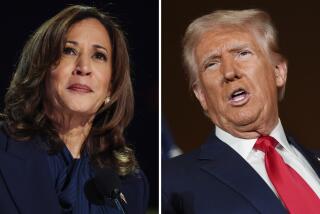Measure Could Change Landscape for Investors
- Share via
Congress is about to create a new world for many investors.
The tax bill would slash the maximum federal tax rates on cash dividends and capital gains to the same level -- 15% -- for at least the next five years.
For the record:
12:00 a.m. May 24, 2003 For The Record
Los Angeles Times Saturday May 24, 2003 Home Edition Main News Part A Page 2 National Desk 1 inches; 63 words Type of Material: Correction
Tax cut dates -- An article on Congress’ tax bill in Friday’s Business section reported an incorrect effective date for the federal tax cut on capital gains. The new top tax rate of 15% applies to gains realized on or after May 6, not Jan. 1. As reported, the 15% maximum tax rate for dividends applies to any qualified dividend received in 2003.
That could challenge many long-held assumptions about the appeal of dividends compared with capital gains and bond interest, and thus has potentially major implications for financial markets.
Here are answers to some questions investors may have about the proposed changes, which Congress is expected to approve by the weekend:
Question: How would my current stock portfolio be affected?
Answer: Effective this tax year, the maximum tax owed on cash dividends received from most companies would drop to 15%. The top rate has been 38.6%, so some investors would see their dividend tax bill reduced by more than half.
Also this tax year, the maximum tax rate on capital gains -- that is, any realized profit on securities held more than one year -- would fall by one-quarter, to 15% from the current 20%.
The lower rates would be in effect through 2008, unless extended by Congress.
These changes, in theory aimed at stimulating the economy, are a compromise from the tax plan President Bush proposed in January. The Bush plan sought to eliminate the tax on dividend income on the grounds that dividends were subject to “double taxation” -- that is, companies owe tax on their gross earnings, and then shareholders owe tax on dividends paid out of companies’ net profits.
But some in Congress found the Bush plan too expensive.
Q: What about my stock mutual funds?
A: Qualified dividends and capital gains paid by mutual funds would be subject to the lower tax rates, according to the Investment Company Institute, the funds’ chief trade group in Washington.
As they do now, funds would tell investors each year what portion of their earnings were in dividends versus capital gains.
Q: Would all stock dividends be eligible for the lower rate?
A: No. Real estate investment trust dividends would not qualify for the 15% rate, because most REITs don’t pay corporate income taxes. REIT dividends would be taxed at ordinary income tax rates, according to the National Assn. of REITs.
Also, so-called preferred stocks may not qualify, depending on how the securities are structured, tax experts say. If the income generated by a preferred stock is considered to be interest rather than a dividend, it would be subject to ordinary tax rates, experts say.
Q: Have dividend and capital gains tax rates ever been lower than in the current proposal?
A: The new dividend tax rate apparently would be the lowest since before World War I.
However, from 1964 to 1986, Congress allowed a small amount of dividends to be excluded from tax. For most of that period, the exclusion was $100 per annual dividends earned per taxpayer. The exclusion was eliminated in 1986.
As for the capital gains tax rate, Sen. Charles E. Grassley (R-Iowa) said Thursday that the proposed rate would be the lowest since 1934.
Q: Given the sharp reduction in the tax on dividend income, wouldn’t dividends automatically become a lot more attractive to most investors?
A: Many financial advisors think so. “A lot of shareholders are going to like dividends now,” said Al Kugel, senior investment strategist at Stein Roe Investment Counsel in Chicago.
That would be a big change. Many investors, and companies, grew to disdain dividends over the last decade because the tax rate differential made it much more appealing for investors to focus on capital gains. That view was reinforced as share prices soared in the 1990s.
But as many investors have learned over the last three years as stock prices plunged, “Capital gains can be ephemeral,” Kugel said. By contrast, “A dividend is money in your pocket.”
In most cases, once a company begins to pay a dividend it does so religiously each quarter. Dividend cuts are relative rarities because they send a troubling signal about a company’s financial picture.
In the recession year of 2001, for example, just 205 companies cut or omitted their dividends, according to Standard & Poor’s, which tracks such payments. By contrast, 1,326 companies raised their dividends that year, and many thousands more continued to make payments at the same rate as in 2000.
Q: If the bill becomes law, might it trigger a rush by investors to buy high-dividend-paying stocks?
A: It could. But experts note that many investors have been mulling over the idea of a dividend-tax elimination since Bush proposed it in January. So expectations of more favorable tax treatment for dividends arguably have been “in the market” for a while, and may already have helped boost some stocks.
“Certainly it enhances the appeal of dividend-paying stocks,” said Charles Carlson, editor of DRIP Investor in Hammond, Ind., a newsletter focusing on stocks with dividend reinvestment plans.
Still, he doesn’t see a mad rush into stocks that pay generous dividends. It will take time to change investors’ thinking with regard to dividends versus capital gains income, Carlson and others say.
The annualized dividend yield on many blue-chip stocks is in the range of 2% to 3%. (The yield is the dividend divided by the stock price.)
Investors would keep more of that return if tax rates are slashed. But those yields still pale compared with the capital gains that are possible if investors pick winning stocks.
General Electric Co., for example, pays an annual dividend of 76 cents a share. At Thursday’s closing stock price of $27.73, the dividend yield is 2.7%.
But an investor who bought the stock Dec. 31 has a capital gain, at least on paper, of 13.9% so far this year. That’s more than five times the dividend yield.
Q. Have dividends and capital gains ever before been taxed at the same rate?
A: Yes. Both were taxed at a maximum rate of 28% in 1988 and 1989. The investment playing field wasn’t dramatically altered in that period because of the tax structure, experts say.
Q: Would the proposed tax rate changes put more pressure on companies to raise their dividends, or to begin paying them?
A: Most experts believe that would be true, over time.
Entertainment giant Viacom Inc., for example, does not pay shareholders a dividend. But this week, Chairman Sumner Redstone told investors at the company’s annual meeting that “as soon as tax relief is granted in respect to the dividend, our board will give very serious consideration to dividends.”
But dividends are paid out of earnings, and at many companies the bottom line has just begun to recover over the last year after profit plunged in 2000 and 2001. It will take a healthier economy to give companies the wherewithal to pay higher dividends, analysts note.
Q: Could lower dividend tax rates make some stocks more attractive income-generating investments than bonds, including tax-free municipal bonds?
A: That’s possible. Bond interest would continue to be taxed at ordinary tax rates, as high as 35%.
An investor who buys a 10-year Treasury note today would earn an annual interest yield of about 3.3%. In the 35% tax bracket, the after-tax yield would be 2.15%.
If the same investor instead could earn a 3.3% dividend yield on a stock, the after-tax yield (at the 15% tax rate) would be 2.8%.
Also, stocks offer the potential for increasing dividends over time, while most bonds pay interest at a rate that is fixed for the life of the security.
But with a high-quality bond, an investor can generally count on getting all of his principal back when the bond matures. With stocks, there’s no guarantee of principal value, even if dividend income continues.
Tom Petruno can be reached at tom.petruno@latimes.com.
More to Read
Inside the business of entertainment
The Wide Shot brings you news, analysis and insights on everything from streaming wars to production — and what it all means for the future.
You may occasionally receive promotional content from the Los Angeles Times.










